Ad Code
Translate
Smart strategies for trading on crypto exchanges
October 20, 2025
Five Do’s For a Healthy Turnover That Bolsters Talent-Retention
October 20, 2025
Discover Honeybee Pharmacy (2025 Guide Important Consumer Tips)
October 14, 2025
What is Ozempic (semaglutide)? (Updated in 2025)
January 30, 2025
How To Find Suitable Properties In Cyprus?
October 20, 2025
Posture Bra: Improving Back Support and Comfort
October 20, 2025
10 Effective Strategies to Improve Domain Authority of Your Website
October 20, 2025
How Many Acres Do You Need for a Cattle Ranch?
Khabza Mkhize
February 28, 2023
You've decided to start a cattle ranch. The research has been done, and there is a solid business plan to guide you through the journey. One of the most important things you'll have to keep in mind is buying the land. You can always go right with purchasing land that is too big. Going too small could lead to a host of problems. Soil erosion, lack of feeds, and limited movement are some of the challenges you might face when the land is too small. This begs the question, how many acres of land do you need for a cattle ranch.
Think About The Location
Budgeting For The Ranches
The cost of buying land will be one of many to consider. How much you're willing to spend will also be a determining factor in the size of land that you can spend. You should stay above what is reasonable for the property, as you could set yourself up for failure even before starting. You also have to budget for the ranch's staff, equipment, and general maintenance. You're likely to pay more for the production ranch if it is near a popular setting.You can sacrifice to be away from civilization if you want to get more for the money you'll be spending on purchasing the land. Working with a real estate agent that deals with ranches will save you time and money on the research. They will provide details on the rangelands, water sources, cattle market, and soil types so you can research such information with others.
Cattle Ranch Acreage
Experts recommend having 1.5 acres per cow. That means that you'll need at least 250 acres to have 50 cows on the ranch. You can start with more ambitious numbers if it is the first attempt at establishing a farm. Starting small doesn't mean you forget about room for expansion as you grow the herd. You can still buy an oversized parcel of land and start with a few cows and keep adding as you get comfortable and gain experience with the process.Earning Goals
Ultimately, the main goal of starting a ranch is so you can make money with meat production. The amount of money you make is mainly determined by the success of your endeavours. You're likely to make more profit with an increase in the number of cows. The yield per cow could be as high as $200 annually. Starting a ranch should be seen as something other than a get-rich-quick-scheme as numerous challenges are involved. Experienced ranchers tend to make more money than those just starting out.Research Cattle Breeds
If you're starting from the bottom, you should be focused on learning about the different cattle breeds. Some cows may look like beef cows, but that is not always the case. This is particularly true for dual-purpose species. You'll also need to learn about the different beef categories.Ongoing Costs
You can reduce the annual budgets by being keen on the weather patterns and climatic conditions to make the necessary adjustments when it comes to planning. According to statistics, feed costs will make up 25% of the total annual ranch costs. There are other recurring expenses, such as payroll, which you'll need to factor in when creating an expense list.Making the Business Profitable
The annual profits will be tied to production. As a new farmer, you should focus on your strengths, but that doesn't mean you shouldn't take advantage of the industry's opportunities. You can sell cowhides, offer breeding services, host tours, and even showcase at local events. The onus is on you to be creative when identifying the different ways you can make extra money with your ranch.Featured Post
DL Mining Launches Ethereum Contract Participation Service, Helping Users Earn $2K Stable Daily Returns
Zizo Gala-Mkhize-
October 20, 2025
Soapie Teasers
Sister Sites
Most Popular
List of 6,000+ Dofollow Commentluv Blogs FREE (Updated 2025)
January 16, 2025
Five Do’s For a Healthy Turnover That Bolsters Talent-Retention
October 20, 2025
What is Ozempic (semaglutide)? (Updated in 2025)
January 30, 2025
Popular posts
List of 6,000+ Dofollow Commentluv Blogs FREE (Updated 2025)
January 16, 2025
Five Do’s For a Healthy Turnover That Bolsters Talent-Retention
October 20, 2025
Smart strategies for trading on crypto exchanges
October 20, 2025
Footer Menu Widget
Created By Blogspot Theme | Distributed By Gooyaabi Templates



Social Plugin